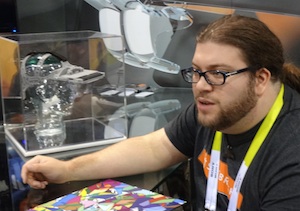
Wayne Torres-Rivera, Seebright’s developer community manager, pitches next-gen headset at CES.
There were as many companies from Santa Cruz exhibiting at last week’s Consumer Electronics Show in Las Vegas as there were from all of South America. And twice as many as Africa. Which is to say, there were 2. One was Plantronics aimed at, among other things, robotics, security and authentication applications, and supported by SDKs for the developers they hope to attract.
The other Santa Cruz company was Seebright, a virtual and augmented reality start-up. Its booth was jammed with people trying on the company’s first generation headset, which uses a smart phone – pretty much any Android or iOS device with a screen in the 5 to 6 inch range – to either place a translucent 3D overlay on the real world or drive an immersive virtual reality experience.
A second generation headset with a much slicker look is in the pipeline, with plans to take it to Kickstarter, perhaps as soon as February. Target price is $150 for the headset and included hand-held controller. Using a physical device rather than gestures is part of the company’s strategy of targeting gamers and industrial app developers, who need a higher level of control granularity.
“Vertical markets are going to be very important for this,” said Bill Keating, Seebright’s COO. An SDK is available and the company particularly wants to appeal to developers with an interest in adding a virtual or augmented reality experience to existing apps.
So far, apps developed for the Seebright headset include a virtual art gallery and a treatment for lazy eye disorder.
